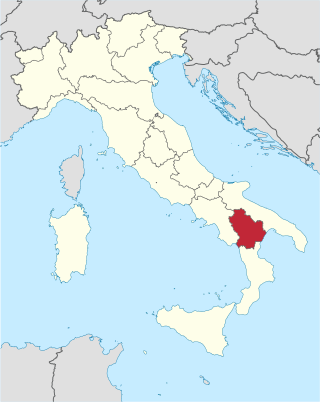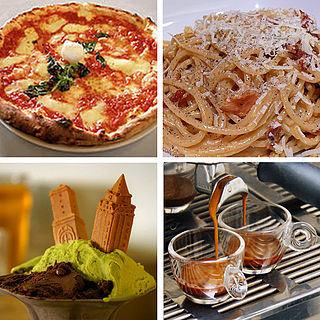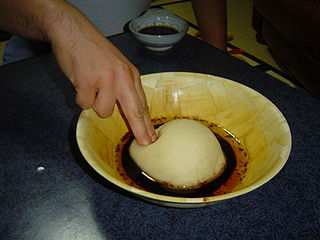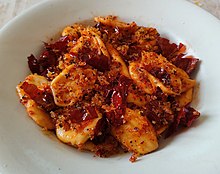
Pasta is a type of food typically made from an unleavened dough of wheat flour mixed with water or eggs, and formed into sheets or other shapes, then cooked by boiling or baking. Pasta was traditionally only made with durum, although the definition has been expanded to include alternatives for a gluten-free diet, such as rice flour, or legumes such as beans or lentils. While Asian noodles are believed to have originated in China, pasta is believed to have independently originated in Italy and is a staple food of Italian cuisine, with evidence of Etruscans making pasta as early as 400 BCE in Italy.

Gnocchi are a varied family of dumpling in Italian cuisine. They are made of small lumps of dough, such as those composed of a simple combination of wheat flour, potato, egg, and salt. Variations of the dish supplement the simple recipe with flavour additives, such as semolina flour, cheese, breadcrumbs, cornmeal or similar ingredients, and possibly including herbs, vegetables, and other ingredients. Base ingredients may be substituted with alternatives such as sweet potatoes for potatoes or rice flour for wheat flour. Such variations are often considered to be non-traditional.

Basilicata, also known by its ancient name Lucania, is an administrative region in Southern Italy, bordering on Campania to the west, Apulia to the north and east, and Calabria to the south. It has two coastlines: a 30-km stretch on the Tyrrhenian Sea between Campania and Calabria, and a longer coastline along the Gulf of Taranto between Calabria and Apulia. The region can be thought of as the "instep" of the "boot" of Italy, with Calabria functioning as the "toe" and Apulia the "heel".

Peperoncino is the generic Italian name for hot chili peppers, specifically some regional cultivars of the species Capsicum annuum and C. frutescens. The sweet pepper is called peperone in Italian. Like most peppers, the fruit is green or yellowish-green when young, and ripens to a red color.

Peasant foods are dishes eaten by peasants, made from accessible and inexpensive ingredients.

Italian cuisine is a Mediterranean cuisine consisting of the ingredients, recipes and cooking techniques developed in Italy since Roman times and later spread around the world together with waves of Italian diaspora. Some of these foods were imported from other cultures. Significant changes occurred with the colonization of the Americas and the introduction of potatoes, tomatoes, capsicums, maize and sugar beet—the latter introduced in quantity in the 18th century. It is one of the best-known and most appreciated gastronomies worldwide.

Uruguayan cuisine is a fusion of cuisines from several European countries, especially of Mediterranean foods from Spain, Italy, Portugal and France. Other influences on the cuisine resulted from immigration from countries such as Germany and Scotland. Uruguayan gastronomy is a result of immigration, rather than local Amerindian cuisine, because of late-19th and early 20th century immigration waves of, mostly, Italians. Spanish influences are abundant: desserts like churros, flan, ensaimadas yoo (Catalan sweet bread), and alfajores were all brought from Spain. There are also all kinds of stews known as guisos or estofados, arroces, and fabada. All of the guisos and traditional pucheros (stews) are also of Spanish origin. Uruguayan preparations of fish, such as dried salt cod (bacalao), calamari, and octopus, originate from the Basque and Galician regions, and also Portugal. Due to its strong Italian tradition, all of the famous Italian pasta dishes are present in Uruguay including ravioli, lasagne, tortellini, fettuccine, and the traditional gnocchi. Although the pasta can be served with many sauces, there is one special sauce that was created by Uruguayans. Caruso sauce is a pasta sauce made from double cream, meat, onions, ham and mushrooms. It is very popular with sorrentinos and agnolotti. Additionally, there is Germanic influence in Uruguayan cuisine as well, particularly in sweet dishes. The pastries known as bizcochos are Germanic in origin: croissants, known as medialunas, are the most popular of these, and can be found in two varieties: butter- and lard-based. Also German in origin are the Berlinese known as bolas de fraile, and the rolls called piononos. The facturas were re-christened with local names given the difficult German phonology, and usually Uruguayanized by the addition of a dulce de leche filling. Even dishes like chucrut (sauerkraut) have also made it into mainstream Uruguayan dishes.

Tunisian cuisine, the cuisine of Tunisia, consists of the cooking traditions, ingredients, recipes and techniques developed in Tunisia since antiquity. It is mainly a blend of Mediterranean and native Punics-Berber cuisine. Historically, Tunisian cuisine witnessed influence and exchanges with many cultures and nations like Italians, Andalusians, French and Arabs.

Neapolitan cuisine has ancient historical roots that date back to the Greco-Roman period, which was enriched over the centuries by the influence of the different cultures that controlled Naples and its kingdoms, such as that of Aragon and France.

The cuisine of Libya is a mix of Berber, Arab and Mediterranean cuisines with Ottoman and Italian influence. One of the most popular Libyan dishes is bazin, an unleavened bread prepared with barley, water and salt. Bazin is prepared by boiling barley flour in water and then beating it to create a dough using a magraf, which is a unique stick designed for this purpose.

Spaghetti aglio e olio is a pasta dish typical of the Italian city of Naples. It is a typical dish of Neapolitan cuisine and is widely popular. Its popularity can be attributed to it being simple to prepare and the fact that it makes use of inexpensive, readily available ingredients that have long shelf lives in a pantry.

The traditional cuisine of Abruzzo is eclectic, drawing on pastoral, mountain, and coastal cuisine. Staples of Abruzzo cuisine include bread, pasta, meat, fish, cheese, and wine. The isolation which has characterized the region for centuries has ensured the independence of its culinary tradition from those of nearby regions. Local cuisine was widely appreciated in a 2013 survey among foreign tourists.

Ciceri e tria is a pasta dish originating in the Salento region. It is prepared with pasta and chickpeas as primary ingredients, and includes fried pasta. It has been described as a "classic and emblematic dish of Salentine cuisine" and as a specialty dish of Apulia.

Apulian cuisine consists of the cooking traditions and practices of the region of Apulia in Italy. Starting from the Middle Ages the permanent residence of the nobility in the region gradually declined, which caused the disappearance of their noble cuisine over time. As the common people suffered from poverty, their culinary tradition adapted to use cheap and simple foods. Bread, vegetables and pasta have the leading role in the cuisine. Fruits, fish and wine are consumed frequently as well, but meat plays a minor role. The food of Apulia is known as a prime example of cucina povera or 'cuisine of the poor', characterizing its simplicity rather than its quality. Moreover, the simple dishes allow the quality of their local and seasonal ingredients to take center stage.

The capuliato or capuliatu is a traditional condiment of Sicilian cuisine based on dried tomatoes, linked, in particular to the territory of the Vittoria Plain, in free municipal consortium of Ragusa. The original name is capuliato, meaning 'minced'.

The peperone crusco, also known as crusco pepper, is a typical product of the Basilicata region of Italy.

The cuisine of Basilicata, or Lucanian cuisine, is the cuisine of the Basilicata region of Italy. It is mainly based on the use of pork and sheep meat, legumes, cereals and vegetables, with the addition of aromas such as hot peppers, powdered raw peppers and horseradish. The local gastronomy is, for historical-cultural reasons, typically peasant, based on simple recipes and on the culture of reuse, in particular of meat and bread.















